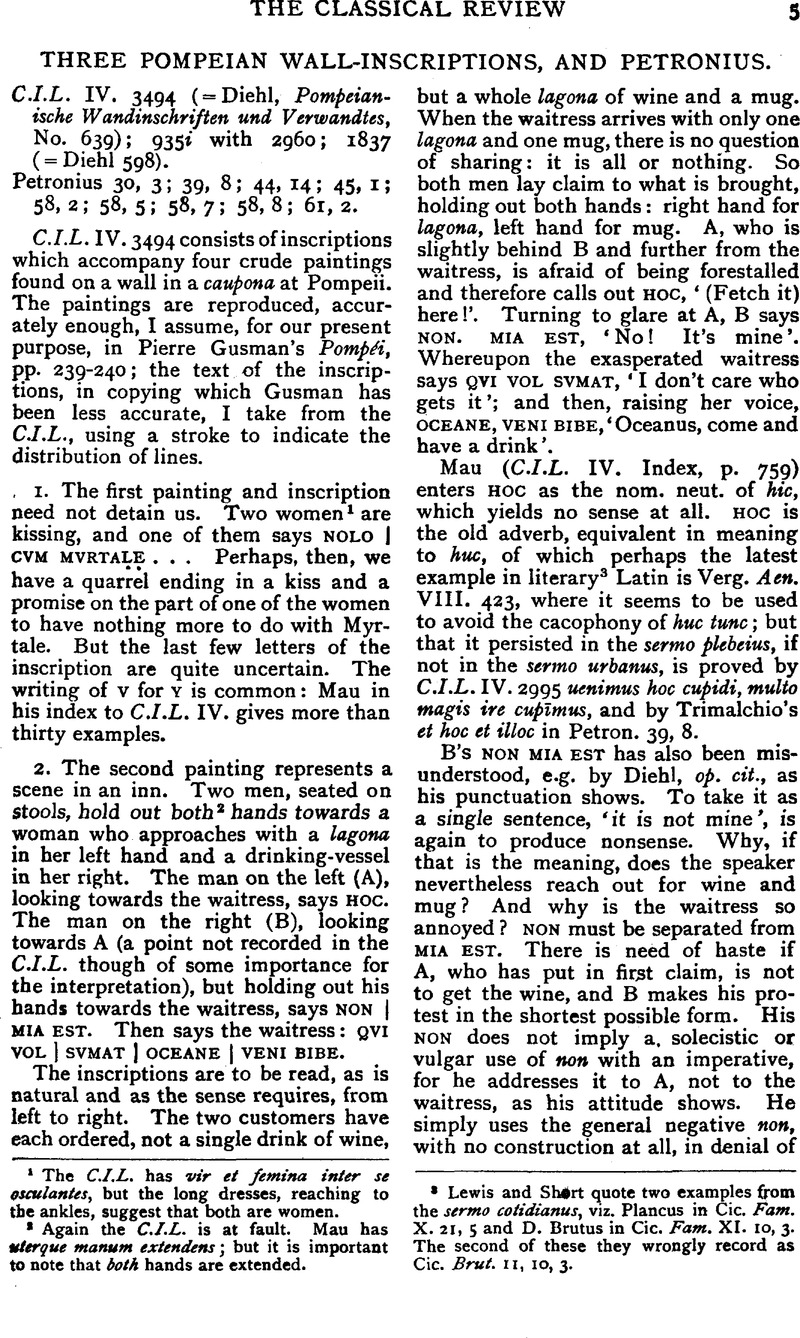Article contents
Three Pompeian Wall–Inscriptions, and Petronius
Published online by Cambridge University Press: 27 October 2009
Abstract

- Type
- Review Article
- Information
- Copyright
- Copyright © The Classical Association 1939
References
page 5 note 1 The C.I.L. has vir et femina inter se osculantes, but the long dresses, reaching to the ankles, suggest that both are women.
page 5 note 2 Again the C.I.L. is at fault. Mau has uterque manum extendens; but it is important to note that both hands are extended.
page 5 note 3 Lewis and Shirt quote two examples from the sermo colidianus, viz. Plancus in Cic. Fam. X. 21, 5 and D. Brutus in Cic. Fam. XI. 10, 3. The second of these they wrongly record as Cic. Brut. 11, 10, 3.
page 6 note 1 Mau's vas vinarium leaves the gender of MIA unexplained.
page 6 note 2 The wall-inscriptions do not exhibit any abbreviation of any part of uolo. In 4200 (quisquis amat ueniat, Veneri lumbos uo), where Mau records uo=uolo, the writer stopped short at uo on realizing that his memory was at fault. He was trying to remember the verses found in 1824: quisquis amat ueniat, Veneri uolo frangere costas, | fustibus et lumbos debilitare deae.
page 6 note 3 See e.g. Sommer, Laut–und Formenlehre (1914), pp. 299 ff., and the indices to C.I.L. IV. and Diehl op. cit.
page 6 note 4 Sommer, Lc. Only one example at Pomeii, viz. C.J.L. IV. 4966 tabifican(t)que.Google Scholar
page 6 note 5 C.I.L. IV. 4966 posquam; 6820 pos fata. In 2058 þos Idus Maias there is some uncertainty.Google Scholar
page 6 note 6 For aled see the end of this article.Google Scholar
page 6 note 7 The C.I.L. gives the fritillus to the other player, but I assume that Gusman's copy is to be trusted, the more readily because it accords better with what the players say.Google Scholar
page 7 note 1 Sc. idcta est; or perhaps simply juit: ’was on my side, in my lot’.Google Scholar
page 7 note 2 For C.I.L. IV. 2960, where Mau (p. 462) conjectured ORTE for Zangemeister's OTJTE, see below.Google Scholar
page 7 note 3 See the very full discussion in Heerdegen, Untersuchungen zur lat. Semasiologie, Heft 3, esp. pp. 68–74.
page 8 note 1 My colleague Dr. G. E. Neumann, who did notknow the purpose of my enquiry, gave me as an example of this ‘Ausruf des Protestes, …der Entrustung’, one that comes very near to our inscription:
A. Du hast gemogelt (beim Kartenspielen).
B. Ich bitte dich; das ist nicht wahr.
page 8 note 2 C.I.L. IV.762, 3775. 5339; in 4507 aegrota.
page 8 note 3 See the indices to C.I.L. IV. and the examples recorded by Diehl.
- 1
- Cited by


